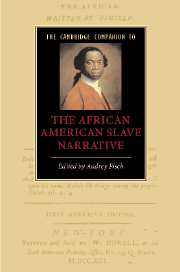Book contents
- Frontmatter
- Introduction
- Part I: The Slave Narrative and Transnational Abolitionism
- Part II: The Slave Narrative and Anglo-American Literary Traditions
- Part III: The Slave Narrative and the African American Literary Tradition
- 8 The slave narrative and early black American literature
- 9 Telling slavery in “freedom’s” time: post-Reconstruction and the Harlem Renaissance
- 10 Neo-slave narratives
- Part IV: The Slave Narrative and the Politics of Knowledge
- Further Reading
- Index
9 - Telling slavery in “freedom’s” time: post-Reconstruction and the Harlem Renaissance
from Part III: - The Slave Narrative and the African American Literary Tradition
Published online by Cambridge University Press: 28 July 2007
- Frontmatter
- Introduction
- Part I: The Slave Narrative and Transnational Abolitionism
- Part II: The Slave Narrative and Anglo-American Literary Traditions
- Part III: The Slave Narrative and the African American Literary Tradition
- 8 The slave narrative and early black American literature
- 9 Telling slavery in “freedom’s” time: post-Reconstruction and the Harlem Renaissance
- 10 Neo-slave narratives
- Part IV: The Slave Narrative and the Politics of Knowledge
- Further Reading
- Index
Summary
Summarizing the condition of Southern blacks following the Civil War and Reconstruction's end, W. E. B. Du Bois was uncharacteristically terse: “The slave went free; stood a brief moment in the sun; then moved back again toward slavery.” In Du Bois's compressed account of African American history, one phase blurs so easily into the other that the distance separating slavery from freedom is difficult to fathom. The phase during which the “slave went free” and then passed that liquid “moment in the sun” could seem to augur not just the transformation of socio-political circumstances for African Americans, but also the expansion of aesthetic options beyond the realm of personal testimony and the slave narrative. For generations, African American writers had been duty-bound to the conventions of these forms, which had been instrumental in the protracted campaign to end the Atlantic slave trade and to abolish slavery. But inasmuch as the abolition of chattel slavery did not make real Emancipation's proclamation that all former slaves would be “henceforth and forever free,” the slave narrative continued to play a dominant role in African American letters from the end of the Civil War until well into the 1920s. But to observe that the slave narrative remained a viable form well into the 1920s is not to say that African American writers accepted uncritically its salient tactics or conventions. Even as they advanced the genre's political drives, along with its fervent commitments to forging social change, African American writers continually grappled with the generic conventions of the slave narrative. At one level, that grappling offers us an excursion into the dynamics of continuity and change observable in the historical development of any literary genre, but the struggle of African American writers with this distinguished form went beyond generic matters: it bespoke a vexed relationship to the institution of slavery itself.
- Type
- Chapter
- Information
- The Cambridge Companion to the African American Slave Narrative , pp. 150 - 167Publisher: Cambridge University PressPrint publication year: 2007

